| One Cold Polar Bear
Writer Christopher Heagy, at right, cocky before the plunge, shivers 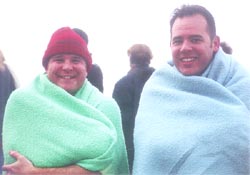 with Bay Weekly general manager Alex Knoll, far right, afterwards. Heagy and Knoll joined more than 1,000 to plunge in the Bay for Maryland Special Olympics. with Bay Weekly general manager Alex Knoll, far right, afterwards. Heagy and Knoll joined more than 1,000 to plunge in the Bay for Maryland Special Olympics.
A month ago it sounded like a good idea.
I had just gotten back from a vacation in San Diego. On a warm December day, as I checked in at Bay Weekly, general manager Alex Knoll asked me to join him in the Polar Bear Plunge for Special Olympics in January. I figured what the heck, how bad could it be?
Worse than I ever imagined.
Flash forward a month to January 22. It’s 25 degrees and I’m not wearing a shirt. I’m bouncing up and down trying to find a way to stay less cold and waiting for the word to run into Chesapeake Bay. My friend and fellow plunger Dave Hiltabidal just did a topless belly flop into a snow bank. I can’t think of any reason to do this to myself.
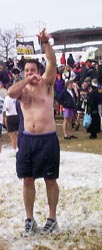
Shirtless, veteran plunger Alex Knoll strolls down to the beach wrapped in a towel. He has a plan. Knoll slips his towel under a photographer’s tripod 20 yards from the water. Not knowing any better, I leave my bag with my roommate 300 yards from the Bay.
Knoll, I and over a thousand other shivering men and women cram together, trying to fit into a group photo. We linger a couple more cold minutes until the celebrity plungers are found so the countdown can begin.
The moment is here. There’s no backing out now. The only place to go is in the water.
3 … 2 … 1 … I head for the Bay.
I’m in the middle of the pack, looking for open space, slowly jogging forward. I’m just one of 1,021 plungers, with just $140 of the $212,000 raised.
At water’s edge, I stop and think. I look for my friends. I think about what might happen. Searching for answers and not finding any, I bound into the water. I’m quickly up to my waist when I let out a whimper. If I’m ever going under the time is now. I grab a breath and flop in.
Coming up, I feel some of the sharpest pains I have ever known. I realize my towel and blanket are 300 yards away. If I stay in any longer, I don’t think I’ll be able to walk that far.
People told me that when you jump in 32-degree water, you lose your breath and you can’t catch it. I didn’t have that problem. The moment I hit the water, my body went numb. It didn’t happen slowly. It happened instantly. My foot has fallen asleep before and felt like it was being poked with pins and needles. This felt like knives pushed through the bones of my feet. The longer I stayed in the water, the farther the knives reached — into my calves, knees and thighs.
I like to think I was in the water for 30 seconds but it was 15 at the most. Lumb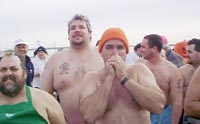 ering back to my towel, I still couldn’t feel my feet. With each step I felt like I was landing on my shins. ering back to my towel, I still couldn’t feel my feet. With each step I felt like I was landing on my shins.
With my towel around my shoulders, I took off my shoes as fast as I could, but that wasn’t very fast. With frozen hands, I tried to pull on a warm pair of socks. Once I did that, I realized I would live.
The immersion was like a dream. When I got to the water’s edge, I was surrounded by over a thousand people, but I didn’t hear a sound. I didn’t recognize or even see anybody around me. The numbness in my feet lingered, but the pain that felt so real those few minutes faded. I still know it hurt, but now I can’t recall how bad. In some way, it seems like someone else went into the water.
I went home and jumped in the shower. Warm water never felt so good. Dressed, I felt alive again.
The Polar Bear Plunge is one of those things I am glad I did, but I doubt I will ever do it again.
But who knows? Maybe next December it won’t seen like such a bad idea.
Bay Life: ‘Pepper’ Langley Carved a Legend
Mother Nature was promising snow. The roads remained icy, the air bitter col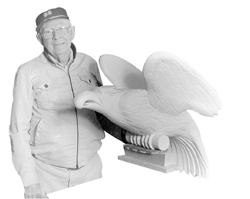 d. Why would anyone want to be down by the water on such a wintry Sunday afternoon? d. Why would anyone want to be down by the water on such a wintry Sunday afternoon?
‘Pepper’ Langley is the answer. This Solomons icon with a smile as warm as his nickname was being honored at the Calvert Marine Museum. The nickname comes from ‘Pepper’ Martin, who starred for the St. Louis Cardinals’ back when Langley was a hot second baseman for Solomons High School.
James LeRoy Langley’s entire 84 years have been played pretty much that same way. But he turned his enthusiasm to shipbuilding, woodcarving and lettering.
“All my life — since I’ve been a kid — I’ve liked boats,” Langley is quoted as saying in the book I Remember — Recollections of Pepper Langley Growing up in Solomons as related to Melvin A. Conant. Conant, biographer and fellow sailor and model maker, was one of 200 on hand to honor his longtime friend
“I’d go down to the shipyard and ask would they build me a boat. Few know that shipbuilders are not model makers; there’d be very few who could build a model … I had a lot of promises but never did get no model. So, when I grew up, I was going to build all the models I wanted, and the Good Lord has given me the power up to now to do it.”
During the Depression, teenaged Pepper took a job as a woodcarver for the M.M. Davis & Son Ship Builders, where he began to also repair and paint boats. He worked there on and off for 16 years, alternating jobs at the Annapolis Yacht Yard and in Baltimore at the Maryland Dry Docks. The bombing of Pearl Harbor brought much-needed work back to Solomons in the form of repairs of the ships for the Army’s Quartermaster Corps. Many rich people had taken up residence on their yachts, and working for them Langley mastered the craft of lettering, often in gold. Langley had not lost his love of building models, which led him to Patuxent Naval Air Center where he built test models for the military for 16 years. He retired in 1963 to open his own sign and boat building business.
Langley’s love for the water flowered in many ways. In the late ’60s the Calvert Marine Museum formed as an idea in Pepper’s mind. With much talk and planning with Captain Joe Lore and the Calvert County Historical Society, that idea became a dream. The museum opened in October 1970. By 1988, Pepper had logged over 2,500 volunteer hours.
“Pepper has many of his works hanging right here at the museum,” said Cindy Smith, a secretary at the museum and a family friend. “You pass right under one as you come in.” That’s the two-inch thick mahogany entrance sign that reads Calvert Marine Museum.
Before refreshments came honors. Former County Commissioner Hagner Mister, now assistant secretary of the Maryland Department of Agriculture, presented a certificate of honor from Maryland Gov. Parris Glendening. Museum Director Doug Alves added a certificate of appreciation.
Pepper smiled and returned the thanks. As I snapped some pictures, he held up his book. “Use these in here, I look much better,” he laughed.
Oshus and Shelly:
How One Woman’s Brainchild Is Saving the Bay
As more and more of us come to live around Chesapeake Bay, we become part of the problem.
Jennifer Keats Curtis, of Annapolis, believes she is part of the solution. Well, her and a couple of oysters.
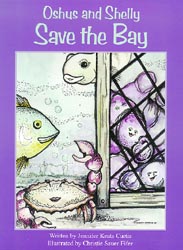
Six years ago, Curtis penned a children’s story about how hard these marine animals work for the Bay. Her story tells the tale of two unlikely heroes, a brother and sister oyster, who search for a way to clean the Bay.
“You can’t pet them. They don’t move. They’re not fuzzy. We had to make them fun and interesting to draw attention. And that’s why I made the oysters heros,” Curtis says.
Publishers weren’t convinced, so Curtis shelved her book and moved on.
Until last year, when Curtis found an ally in the Severn River Association. The venerable and powerful Bay interest group loved the oyster siblings.
“There wasn’t much of a decision,” says Jane Sinclair, president of the association. “Having three small children, I looked at it and thought it was terrific.”
Curtis, aware of the opportunities for teens to aid in environmental projects, like those of the Smithsonian, felt something was missing. “I hated to see the little kids miss out on this,” she laments.
Sinclair helped Curtis find a publisher, Bay Media, and the association helped develop lesson plans so the book could be used in Chesapeake Country schools. Oshus and Shelly Save the Bay is approved as a supplement for second to fifth graders in Anne Arundel County.
Now, the story and visual aids go into Maryland schools along with the association’s Oyster Recovery Program.
“When Jennifer and I go into schools with books and oysters, we read it to the children and they get hands-on experience,” Sinclair says. “It makes that oyster come alive.”
For her part, Curtis is “surprised at the number of teachers and students who have never seen oysters. It astonishes me,” she says. “Kids this young don’t always get to learn about what is in their own back yard.”
With Oshus and Shelly, they can.
Five hundred books have been sold, including 200 to Elm Street Development, an environmentally aware developing company, for Millersville Elementary.
One-third of each purchase goes to the association, which uses the money to build and distribute free oyster gardens. These gardens are planted on the bottom of the Bay, a tributary or a creek by association volunteers. Soon they go to work filtering dirt from Bay waters.
In six months, sales of Oshus and Shelly Save the Bay earned the association $1,437.
Curtis hopes that Oshus and Shelly Save the Bay is the first in a series of children’s book about critters of Chesapeake Bay.
“I want children to know that they are not too little to be involved,” says Curtis, a freelance writer in medical journals.
“There are things that they can do to help save their Bay so it will be around when they get older.”
Oshus and Shelly Save the Bay: $10.50 at BeBeep in Annapolis and Severna Park, Black Market Minerals at City Dock, Grauls in Cape St. Claire or Chesapeake Bay Maritime Museum in St. Michael’s. Find more information on www.oysterbook.com or call 410/626-8904 to invite Oshus and Shelly to speak to your class or group.
Galesville’s Waterman’s Garden
Blooms in Winter
photo by Christy Grimes Artist Joan Bell waterside in Galesville with her Waterman’s Garden sculpture.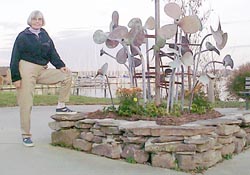
By land and by sea, the new Kunta Kinte-Alex Haley Memorial welcomes visitors to Annapolis. Farther south, bucolic Galesville welcomes visitors with an all-weather garden of boat propellers.
“Being around boats inspired me,” says artist Joan Bell, who created the sculpture and laid the flagstone in Galesville’s waterfront park, over which Waterman’s Garden presides. “Plus, I love to garden,” she adds. “Boat propellers are a perfect floral shape, and I thought, “how perfect for a boat-oriented community like ours.”
This time of year, of course, her Waterman’s Garden is frosted with ice. Which is just fine.
Bell, who as we talk is herself fresh from racing her 30-foot Swan sloop in the Frostbite series, a local regatta, orients herself to boats. She’s also raced the Newport to Bermuda course. But Bell and her husband Peter are newcomers to Chesapeake Country. Hailing from Potomac, they got to know Galesville when they had their sloop overhauled by Hartge Yacht Yard. The lengthy task gave them time to fall in love with the village, so much they shortly moved in.
Bell is a watercolorist who paints, mats and frames her brilliantly hued works in her own studio, a converted carriage house behind her home on Lerch Creek (a body of water far lovelier than its name). The Bells’ three-story home is a former steamboat dance hall. “People would ride the steamboat down from Annapolis, stay the weekend, then reboard and shuttle back to town Sunday nights,” she says.
Like so many who are smitten with Chesapeake Country, Bell wanted to give as well as take. Her sculpture, which she calls a one-time departure from painting, is her contribution.
Galesville is one of few places on the Bay with public waterfront access. Tending this public treasure is an on-going town project. “Six years ago when we started, over 80 tires sat in the water there,” says Sheila Gallagher of the Galesville Heritage Society. Chesapeake Bay Trust funded planting with underwater grasses to control erosion.
As a new Heritage Society member, Bell wanted to dress up the park.
Alex Schlegel of Hartge’s donated the propellers. “We’re packrats,” he says of how he came to have them on hand. “Some of these propellers have been here years. We’d just toss old ones in a parts bin and eventually sell or recycle them.”
Hartge’s shop manager, Rob Nilsen, lent his skill to shape the pipe stems and weld them to the propellers.
“Joan wanted the pipes cut a variety of lengths. She asked me to bend them in different ways, at varying angles,” he says. Result: A finely balanced floral arrangement, the pipes gently curving just as the weight of a real blossom would bend a living stem.
Smith Building Supply’s Francis Ray Moreland, with grandson Thomas, not only donated the stems but also set the sculpture in its concrete base and welded on supports.
And there you have it: “Something subdued, nothing grand or garish,” says sculptor Bell. “Something to blend in with the landscape, especially in winter. There’s something really compelling about the Bay in winter. It has a charm you don’t feel in summer.”
So Galesville’s Waterman’s Garden is at its blooming best right now.
Way Downstream …
In Virginia, the state’s new speaker of the House of Delegates, S. Vance Wilkins, a Republican, is off to a good start. He wants $40 million to purchase tracts of land that could add up to 600,000 acres of open space over the next seven years …
In San Francisco, mamas better not let their babies grow up to be cowboys. The city’s Animal Control and Welfare Commission last week banned rodeo events from steer-wrestling to greased-pig contests, saying they are cruel to animals …
The city of Phoenix achieved a dubious landmark last week: Officials paved over the last city-owned dirt road. Why? To remove every last possible source of particulate pollution, otherwise known as dust …
Polish artist Tomek has left on his world tour called “The Long March of the Jeans” during which he intends to bury his ceramic jeans sculptures on every continent. He began in China, where he put 369 pairs in the ground. Next stop, Africa …
Our Creature Feature this week comes to us from Bangladesh, where you’d better go soon if you want to see one of the last Royal Bengal tigers. According to a recent count, just 350 of the huge, majestic tigers remain, less than half of what roamed the bush in 1995, according to a report at the Global Tiger Forum in Bangladesh last week.
The problem is poachers, who kill the tigers for their skin and for other parts used in medicine in Southeast Asia.
Copyright 2000
Bay Weekly
|